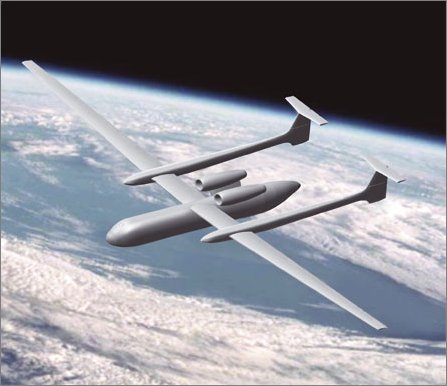The opportunity for technological leapfrogging has seen Japan, South Korea and Singapore explore at least three sophisticated concepts for high-altitude, long-endurance (HALE) systems over the past five years. However, all three nations have recently sought to buy the US Northrop Grumman RQ-4 Global Hawk, potentially paving the way for bilateral or even a multinational enhancement effort on that system.
While initial South Korean concepts were based on a high-altitude autonomous airship aimed at the civil marketplace, that nation now plans to fly a domestically developed military medium-altitude, long-endurance (MALE) UAV prototype in 2007-8. Total proposed funding is put at $440 million, with initial spending starting this year (Flight International ,1-7 November 2005).
|
| The Beluga is just capable of transporting the A380 rear fuselage section from Getafe to Hamburg |
A follow-on, $210 million HALE development effort would be launched in 2008, the timeframes suggesting that a common programme will probably be based on a modular airframe concept.
The South Korean Agency for Defence Development has previously flagged interest in involving a foreign development partner in the programme, with candidates currently including the United Arab Emirates UAV Centre of Excellence, itself planning a MALE research and development effort to meet national military requirements.
Japan began studying a domestic HALE development programme in 1998 as part of its response to North Korean ballistic missile tests. The studies are believed to have included a collaborative effort by Mitsubishi Heavy Industries and other companies looking at indigenous development options, with the conclusion that lead times and cost prevented any near-term solution.
Related joint studies on a notional sensor platform were also carried out in 2000-1 in conjunction with the US Pacific Command, looking at the impact that a HALE UAV could have on Japan’s maritime monitoring and disaster response capabilities.
In January this year Japanese Self- Defence Agency officials confirmed that they plan to proceed with a near-term off-the-shelf HALE acquisition aimed at service entry in 2007-8.
On 2 February, Paul Hester, commander of the US Pacific Air Force, told the US Air Force’s Air Warfare Symposium in Florida that his command was working release issues for a possible Global Hawk sale.
He also revealed that the USAF was pushing for the Japanese aircraft to be based alongside US Global Hawks at Anderson AFB on Guam. “The Japanese have been interested in Global Hawk. They want to buy some if we will release that... I have been in private conversations with them to extend the offer of how they would look at stationing their Global Hawk at Guam.”
Singapore’s own HALE design effort was launched around 1999 and when made public in May 2001, included the revelation that the study team included Scaled Composites head Burt Rutan. The design effort continued until last year, with Singapore now looking at the options of co-operative development with a second nation, or acquiring Global Hawk (Flight International, 28 February–6 March).
Source: Flight International

















